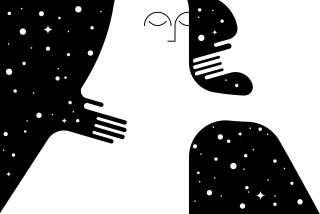Freud’s Theory of Dreams Evolves
- Share via
NEW YORK — Sigmund Freud might concede that sometimes a cigar is just a cigar. But on the larger issue he was adamant--a dream is never just a dream.
Then what is a dream? The question has divided students of the mind for a century.
Freud argued that dreams are windows into an otherwise inaccessible mind, “the royal road to the unconscious.” But others have contended that they are mere static, the random firings of a dormant brain.
*
Insight such as this falls to one’s lot but once in a lifetime.
--Sigmund Freud
*
A century ago a dream was a will-o’-the-wisp, a tantalizing glimpse into a spirit world where truths were revealed and events foretold. But Freud changed all that with a book.
“The Interpretation of Dreams,” published on Nov. 4, 1899, re-created dreams as a powerful probe of the unconscious mind. Suddenly they were messages from a landscape entirely within us, and yet totally unknown.
“Before Freud you would say that dreams were considered as spirits, as otherworldly things, messages from the other world. They were dealt with in religious and philosophical ways,” says psychoanalyst Leon Hoffman. “Through his study he came to the idea that the mind worked outside of our awareness and that dreams had meaning.”
A century later, science is putting Freud to the test. New brain-imaging technologies allow researchers to see which parts of the brain are active during a dream, and which are dead to the world.
“That is helping in being able to test all of the ideas in a scientific way, in a reproducible scientific way,” says Edward Nersessian, a psychoanalyst in New York City.
*
You are innocent when you dream.
--Tom Waits
*
Freud argued that dreams are a person’s most deeply held wishes, expressed in symbolic form. Their purpose? To keep the unconscious drives that constantly pop up within us from waking us in the night.
“That was the essence of Freud’s theory, that dreams protect sleep,” says Mark Solms, a neuroscientist at St. Bartholomew’s and Royal London School of Medicine.
Few psychoanalysts believe that today. But Freud’s more basic idea, that dreams are messages from a part of the mind beyond our conscious control, is stronger than ever.
“He used dreams to try to get at what unconscious processes were and how they work,” Harvard University psychiatrist David Westen says.
Scholars didn’t always support that idea. In 1953, researchers discovered a stage of sleep called REM, for rapid eye movement. During REM sleep much of the brain becomes as active as it is during waking. The eyes dart around behind closed lids as if following an action-packed sporting event. Most intriguing, people awakened from REM sleep almost always say they have been dreaming.
That led researchers to equate REM sleep with dreaming. When they looked for the part of the brain that controls REM, they found that its source is the pons, a primitive section of the brain stem that has more to do with reflexes like breathing than deeply held wishes, desires, hopes and fears.
So Freud must have been wrong, they concluded. Dreams are nothing more than random images conjured up by a senselessly whirring brain, and any meaning we associate with them is imposed by the conscious mind, not generated by the unconscious.
But recent research has shown that REM and dreams are not the same. Solms has studied patients who have brain damage to the pons which renders them incapable of REM sleep. Yet those people still dream. Other people with damage to higher parts of the brain can’t dream. But they do experience REM sleep.
Researchers have also found that REM sleep is not the exclusive province of dreams. Although most dreams happen then, people also dream at other times during sleep.
The recent discoveries have led researchers to the conclusion that REM is merely a trigger for dreaming.
“REM sleep is the best place for dreaming,” says Ernest Hartmann, a professor of psychiatry at Tufts University in Boston. “It is not the only place.”
*
We are the stuff that dreams are made on.
--Prospero
Shakespeare’s “The Tempest”
*
In the last few years, new imaging technologies have shown what parts of the brain are most active during dreaming. Allen Braun of the National Institute on Deafness and other Communication Disorders studies sleeping people with a technology called positron emission tomography, or PET, scanning. What he is finding can be used to test some of Freud’s ideas about dreaming.
“We can see if the patterns are congruent with his ideas,” Braun says.
For example, during dreaming the parts of the brain involved in emotions and emotional memories are active. That explains why dreams can feel so intense and powerful. The areas involved in recognizing objects and processing images are also active--which is consistent with the strong visual nature of dreams.
Meanwhile, the areas that Braun calls the “executive regions of the brain” are deactivated. That might help explain why dreams are often illogical, irrational and out of sequence.
All of those observations are roughly consistent with Freud’s idea of dreams as messages from the unconscious mind. But contrary to what Freud might have predicted, the part of the brain involved in processing symbols is relatively quiet during dreaming. Freud believed that dreams were full of symbols that had to be decoded to reveal the innermost workings of the mind.
“Dreams may be meaningful, but they’re not meaningful in the way Freud thought,” Braun says.
He and several of his colleagues believe that the meaning of dreams is right on the surface. In other words, a cigar is always just a cigar.
*
So I awoke, and behold it was a dream.
--John Bunyan
“The Pilgrim’s Progress”
*
Hartmann, who actually met Freud during the 1930s, also thinks Freud got dreams mostly, but not completely, right.
. “They tell me Freud patted me on the head,” Hartmann says of his meeting with Freud. “He was 80 and I was 2.”
Freud might not react so warmly to Hartmann today.
“I think Freud was very smart,” Hartmann says. “But I do not believe every dream is the fulfillment of a wish.”
Hartmann’s own theory relies on the modern idea that the brain is an intricate web of connected nerve cells. During dreaming we explore that network in ways that are impossible while awake, making broader connections and associations than we otherwise would.
That may explain why artists often find inspiration in dreams, Hartmann argues. But both experience and research show that logical thought is almost completely absent from dreams. Even the most brilliant thinkers rarely find themselves doing arithmetic or solving complex problems in dreams.
“We do less A, B, C, D,” Hartmann says. “We do more fanciful stuff.”






